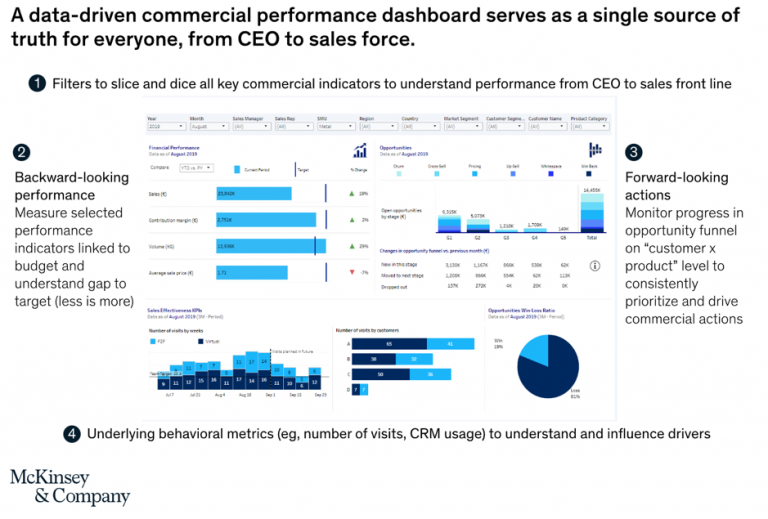
A data-driven organization embraces a culture of data exploration, with company-wide policies and guardrails that ensure accuracy. Both analysts and non-analysts can use data analytics to find answers to critical business questions. In a data-driven organization, everyone can make decisions based on trustworthy, standardized information across multiple systems, teams, and locations worldwide.
When data access is optimized, everyone can benefit from it without being overwhelmed with manual tasks, confused about how to interpret the data, or requiring specialized data science skills. Businesses establish a solid data-driven culture when executives and employees view data as a valuable asset worth investing in. However, turning data into better decisions takes a lot of work.
We had the opportunity to help many companies on their data-driven journeys. There are no international standards to implement or decades-old playbooks to follow. From our experience, we’ve tracked similarities among our best performing data-driven clients. They all have rigorous decision-making processes in place and promote an evidence-based culture.
How to become a data-driven company
From these similarities, our team at Itirra has summarized the most valuable tips for building a data-driven business. You can prepare your company for a successful transformation with the information below. By partnering with an experienced technology company, you can accelerate the transformation, avoid pitfalls in the process, and reap the benefits of data-driven solutions faster.
Collect the right data
The first step is to connect disparate data from each business function, such as marketing, sales, and customer support. Once data sources are connected for analysts to start investigating, they can quickly make an impact, which can go a long way in transforming company culture and convincing key stakeholders to trust data and use it for day-to-day operations.
Invest in collecting data, even if it takes time to be useful. Spending resources investing in knowledge without knowing if it will pay off. Collect data where it is generated, not just in easily accessible storage. Make troubleshooting data collection errors and failures a high priority.

Establish key strategy metrics
To become a data-driven business, companies should focus on critical analysis, separate fact from opinion, and make objective, informed business decisions. A company can’t chase dozens of performance metrics because each team has its favorite set. When they do, everyone gets confused; at worst, people arm themselves with KPIs to express their opinion. That does not resolve disputes – it escalates them.
Metrics must be achievable and must be durable. In other words, you should not change essential metrics regularly. Instead, your optimized metrics must point to what you hope to achieve.
Work with data visionaries
Employees who can perceive the big picture and understand how employees are using data to improve the business are immensely valuable. While this certainly involves analyzing data from marketing, sales, and other departments, the process doesn’t stop there. Data-driven decisions help internal operations, improve customer service and support, and reduce storage costs. It starts with hiring people open to what the data will tell them about the future — visionaries.
Then you can empower everyone in your organization to use data every day. While the analytics team owns the data stack, each employee needs to be able to use relevant data in their existing workflows. At an organizational level, all departments should use the same sources and work towards the same common metrics.
Democratize data access
All the data in the universe is useless if the people who need it to make business decisions can’t access it. Data-driven companies consolidate their data while constantly updating it so employees can always access the most accurate information. For some companies, this means eliminating data silos and democratizing data access effectively.
Of course, there will always be questions about data security and compliance, but providing data access to everyone is an essential feature of a self-service data culture. Always let employees see the data that affects their work. Not only do they need to see this on a granular level, but in a holistic way that helps them see the bigger picture. Your workforce becomes more informed, empowered, and enthusiastic about using data to improve your business.
Enable data self-service
Easy access to your data isn’t doing your business much good if most of your employees don’t understand it or can’t apply it to business problems. You can solve this problem by getting the right data tools based on your goals. It would make it easier for your employees to access, share, and analyze data. You may want to research options that are embeddable directly into the business tools you already use, such as Excel or Tableau.
And make sure you invest in training on these tools. Having an intuitive user interface is not enough. Do your employees understand the fundamentals of data analysis, transformation, statistics, and visualization? For your tool investment to pay off, your employees must understand what each tool offers. Training should use the same data sources so collaborators can compare their data discoveries and explorations.
Educate everyone in your organization on the proper use and interpretation of data. Realize that no one is born data literate, and implement a curriculum to teach everyone how to interpret and use data in their daily work properly. All employees should know how to determine whether they are using metrics, goals, and conclusions correctly.
Hold employees accountable
Technology can only take you so far. You must also develop incentives to encourage employees to use technology and tools. They should also have a way to measure and evaluate the progress of a self-service data culture, meaning that when employees use data effectively to drive business decisions, they are held accountable for their actions and progress. True cultural transformation can only be achieved if employees are rewarded for data-based behavior.
The collaborative and social dimensions of a data-driven self-service culture should also not be underestimated. Without them, you will fail and your investments in software, computing tools, and platforms will go down the drain. But while many organizations pay lip service to this concept of collaboration and openness, few actually put it into practice. Remember, data doesn’t belong to IT, data scientists or analysts. It belongs to everyone in the business. Therefore, your tools must allow everyone to create their own analyzes and visualizations and share their insights with their peers.
Encourage curiosity about your culture. Everyone should be empowered and expected to ask many questions, and resources must be available to provide answers. It is beneficial to break down KPIs into their component parts periodically to shed new light on what the non-curious may view as simple sums or predictions.
Ensure reports are readable
Most employees today have limited skills in analyzing and interpreting data. Thus, it helps simplify reporting by making it visually appealing and easy to read. This way, people can confidently explore them, regardless of their ability and experience. Clear visualizations make it easier for non-technical teams to access, view, understand, and apply data to everyday scenarios.
Accessible and user-friendly reports also contribute to data literacy. As more people interact with data, they are more likely to use it and rely on it to make decisions. Many teams thrive on interactive reports and dashboards that allow employees to access and interact with data in a secure and easy-to-use place. Team members should be able to analyze and iterate on data, ask questions, and get answers all in one platform.

Foster data-driven meetings
Leading data-driven companies aim to deliver cross-functional, data-driven updates to different teams. Best practices suggest that organizations require data teams to participate in such initiatives. Involving the data team allows employees to ask questions of colleagues who know how to answer them, and it also provides additional learning and growth opportunities.
Analysts need to work closely with business peers to drive change together. Intentionally team up employees with different levels of experience and perspectives to reduce bias exhibited by homogeneous groups, as this minimizes blind spots and maximizes solutions’ potential.
Define and review goals
Data is a means, not an end. Get a clear picture of your end goal, how each strategy contributes to it, and what data is available at each step. Give the numbers on the dashboard context beyond their literal value so they can easily answer questions if needed. Know you’ll never be done and accept it.
Use data to set business direction and strategy. Key decision-makers need access to the best data. Past strategic decisions should be tracked, tested, and reassessed in a feedback loop. Executives must enforce the expectation that data will be used to evaluate every decision, and they rely on data to mitigate risk.
Realize that your analytics team will have more work than they can handle, and set priorities rigorously. Ensure your organization has a continuous improvement mindset, always looking for ways to streamline existing processes and capture new data.
Act on predictions about the future. Take the time to use data to make testable tactical predictions, then act on those predictions and feed the results into your process to improve future decision-making. A data-driven decision engine is akin to the scientific method. Historical analysis should focus on discovering why things happened, not just reporting what happened.
Conclusion
There is no ultimate endpoint to data-driven transformation. Like aiming to be efficient, customer-centric, and having the best product, there is no finish line. But as you embark on becoming a data-driven company, the benefits will quickly become apparent – making decisions faster with more confidence, taking directions based on facts rather than gut feelings, and putting data at the heart of every function core culture.
Becoming a data-driven company can seem like a daunting process from the start, especially if your business is behind the curve. But any business can become data-driven by working on prioritizing data investments and getting ready to bake them into your culture.
At Itirra, we provide companies with customized solutions and opportunities to explore potential improvements to support their business goals. For a personalized recommendation based on your unique business model, don’t hesitate to get in touch or schedule a meeting with me.
